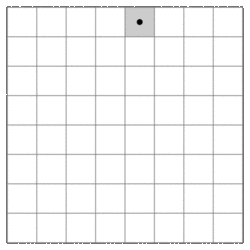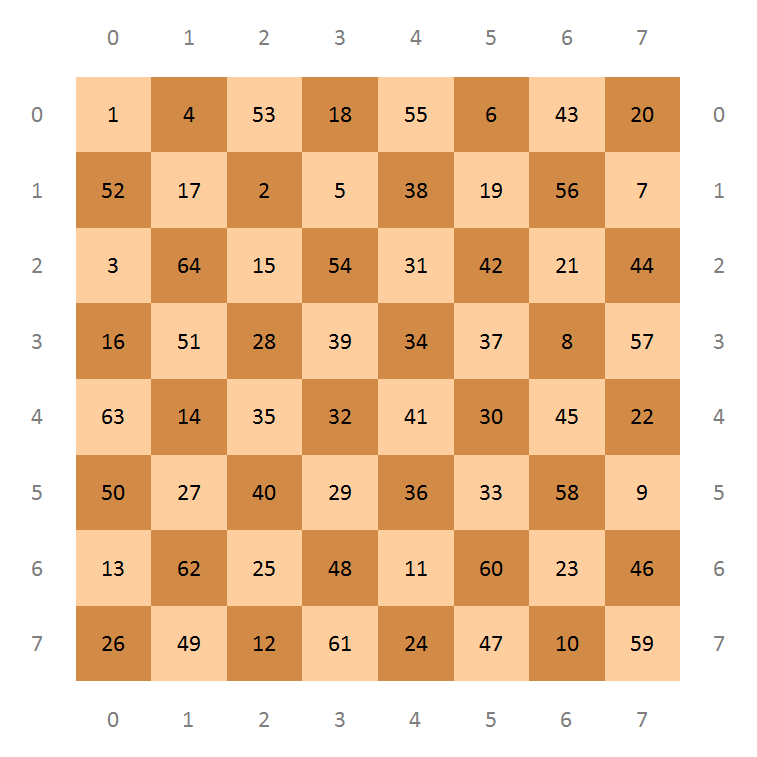A knight moves in an unusual way on a chessboard. Such an L-shaped movement on a chess board is called a horse jump. When it moves, the knight can move to a square that is two squares horizontally and one square vertically, or two squares vertically and one square horizontally. The complete move therefore looks like the letter L. A knight's tour is a sequence of moves of a knight on a chessboard such that the knight visits every square exactly once. If the knight ends on a square that is one knight's move from the beginning square (so that it could tour the board again immediately, following the same path), the tour is closed, otherwise it is open. The exact number of open tours on an $$8 \times 8$$ chessboard is still unknown.

Analogous to a knight's tour, other chess pieces might also make a tour on a chessboard. For example, a tower's tour is a series of displacements in which the tour visits all squares exactly ones.
Assignment
First, write three functions knight, rook and queen that each take two integer arguments representing the row number and the column number of the position of an eponymous chess piece on a $$8 \times 8$$ chessboard. Rows and column indexing starts at 0. Each functions must return the list of positions on the chessboard that can be reached by the chess piece in one single move. Each position is represented as a tuple containing a row number and a column number on the chessboard. The list returned by the function must contain the positions in sorted order according increasing row number and then according to increasing column number.

The sequence of squares visited by a chess piece (i.e. a tour) is represented by labelling the squares of an $$8\times8$$ chessboard with the integers 1 to 64. The number of a square indicates its index in the series of movements on the board. Write a function tour that returns a Boolean value, indicating whether or not a given series of moves represents an open or a closed tour. The series of moves on a board is passed to the function as an $$8\times 8$$ grid, represented as a list of lists. The inner lists represent the rows of the chessboard, having integer elements that represent the labels of the squares on each row. The function also has two optional parameters:
a parameter piece that takes a function that computes for a given position on a chessboard which squares can be reached in a single move of a particular chess piece (the functions knight, rook and queen are examples of such functions); if no argument is passed to this parameter, the function tour should apply horse jumps
a parameter closed that takes a Boolean value, indicating whether the tour should be closed (value True) or if it can also be open (value False; the default value)
Chess rules
For those who are not familiar with the rules of chess: a rook may move an arbitrary number of squares horizontally or vertically. A queen may move an arbitrary number of squares horizontally, vertically or diagonally.
Example
>>> knight(4, 4)
[(2, 3), (2, 5), (3, 2), (3, 6), (5, 2), (5, 6), (6, 3), (6, 5)]
>>> knight(0, 3)
[(1, 1), (1, 5), (2, 2), (2, 4)]
>>> rook(4, 4)
[(0, 4), (1, 4), (2, 4), (3, 4), (4, 0), (4, 1), (4, 2), (4, 3), (4, 5), (4, 6), (4, 7), (5, 4), (6, 4), (7, 4)]
>>> queen(2, 3)
[(0, 1), (0, 3), (0, 5), (1, 2), (1, 3), (1, 4), (2, 0), (2, 1), (2, 2), (2, 4), (2, 5), (2, 6), (2, 7), (3, 2), (3, 3), (3, 4), (4, 1), (4, 3), (4, 5), (5, 0), (5, 3), (5, 6), (6, 3), (6, 7), (7, 3)]
>>> chessboard = [
... [ 3, 22, 49, 56, 5, 20, 47, 58],
... [50, 55, 4, 21, 48, 57, 6, 19],
... [23, 2, 53, 44, 25, 8, 59, 46],
... [54, 51, 24, 1, 60, 45, 18, 7],
... [15, 36, 43, 52, 17, 26, 9, 62],
... [42, 39, 16, 33, 12, 61, 30, 27],
... [35, 14, 37, 40, 29, 32, 63, 10],
... [38, 41, 34, 13, 64, 11, 28, 31]
... ]
>>> tour(chessboard)
True
>>> tour(chessboard, piece=knight, closed=True)
False
>>> tour(chessboard, piece=rook)
False
>>> tour(chessboard, piece=queen)
False
>>> chessboard = [
... [ 1, 2, 3, 4, 5, 6, 7, 8],
... [28, 29, 30, 31, 32, 33, 34, 9],
... [27, 48, 49, 50, 51, 52, 35, 10],
... [26, 47, 60, 61, 62, 53, 36, 11],
... [25, 46, 59, 64, 63, 54, 37, 12],
... [24, 45, 58, 57, 56, 55, 38, 13],
... [23, 44, 43, 42, 41, 40, 39, 14],
... [22, 21, 20, 19, 18, 17, 16, 15]
... ]
>>> tour(chessboard, piece=rook)
True
>>> tour(chessboard, piece=queen)
True
>>> tour(chessboard, piece=queen, closed=True)
False